Fight without mirrors: Nikon J1, Sony NEX-5N, Pentax Q and Panasonic GF3
Talking about each of the presented in the header of the mirrorless separately, we decided to make it difficult: to collect all these cameras and arrange a real fight without mirrors!

Disclaimer: different parameters are important for different people in the cameras, and unfortunately we could not cover all the features and features in this comparative test. In general, do not judge strictly, we tried :)
')
“I got a soap dish - buy a DSLR!” - once this expression meant that a person intends to buy a normal camera, which finally makes good pictures. In fact, the mirror pentaprism has nothing to do with the beauty of the picture - it’s just an optical block of guidance on the subject. The quality of digital photography directly depends on two things:
1. The size of the photosensitive matrix should be as large as possible - and not in pixels, but over the physical area. Ideally, like the so-called full-matrix devices like the Canon 5D, where it corresponds to the frame dimensions of a 35-mm film, that is, 36 × 24 mm.
2. The quality of the lens optics. At the same time, he should have as much aperture as possible, which will help you out in low light without resorting to a flash. To do this, we look at the luminosity value at the end of the lens - the figure should be as small as possible. Whoever has a head inversely proportional, just imagine the Olympic table: the champion has one, the silver has two, and so on.
Where, then, did the clingy analogy cling to means qualitative?
Even in the film era, SLR cameras provided more accurate guidance on long-focus (over 100 mm) lenses. They were the first to get autofocus, displacing more compact rangefinder cameras from the market, after all. It is worth noting that the rangefinder optics were not only smaller but also often much better in quality (take the same Leica).
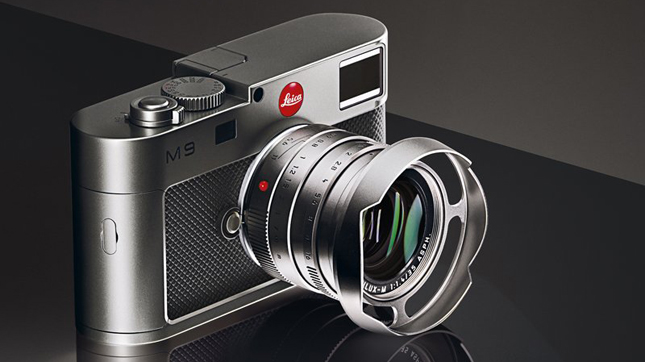
Leica M9 / 18,5-MP, 36x24 mm, 2.5 "display, 5212x3472 pixels, 420,000 rubles for a kit
The bulky dimensions of the cases of SLR cameras came in handy when the first digital APS matrixes began to appear. And although today, like 10 years ago, household mirrors of the matrix are still one and a half times smaller than the film frame, the quality of the pictures on them is noticeably better than that of compacts on sensors with children's nails. In addition, the mirror-shutter design of such cameras allowed to turn on the matrix only at the time of shooting, improving its working conditions.
During these ten years, there have been two factors - technical and everyday. First, the opportunity to make more compact electronic modules in the camera. And secondly, many male amateur photo amateurs have come to disappointing conclusions for themselves. At one time, in obedience to a semi-conscious phallic cult, they were hung up, like Conan the barbarian, with solid ammunition with huge telephones. However, instead of girls, various unpleasant people like Gopniks or guards showed more attention to them (which is, in general, communicating vessels at different times of the day). And by the end of the day, the back didn’t care what it was to hurt - even from the kicks of the crime, even from the weight of the backpack with the lenses. People began to be interested in less overall solutions while maximizing the quality of digital SLRs.
Matrix standard 4: 3 size of 17.3 × 13 mm (which is two times smaller than the Full Frame) was first put Olympus and Panasonic th on the mirror model. The further development of the format in 2008 was expressed in the Micro 4: 3 system: a whole scattering of small bridge cameras appeared with interchangeable lenses on which there was no mirror anymore, and the image was sighted on the screen. The success of the hybrid models involved in the subject and other manufacturers who responded to this demand in different ways. Today, I myself am picking up something compact and able to shoot decently, so I was just glad to have the opportunity to compare the capabilities of several modern bridge cameras.
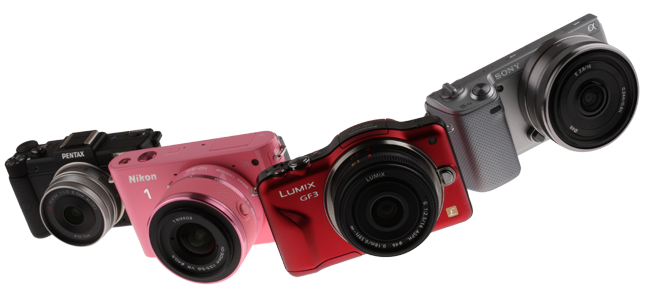
Pentax Q, Nikon J1, Lumix GF3, Sony NEX-5N
For the test, all four cameras with lenses arrived in one lightweight box the size of a package for one (!) DSLR with a whale lens. Despite the general class, the company came across a motley one:
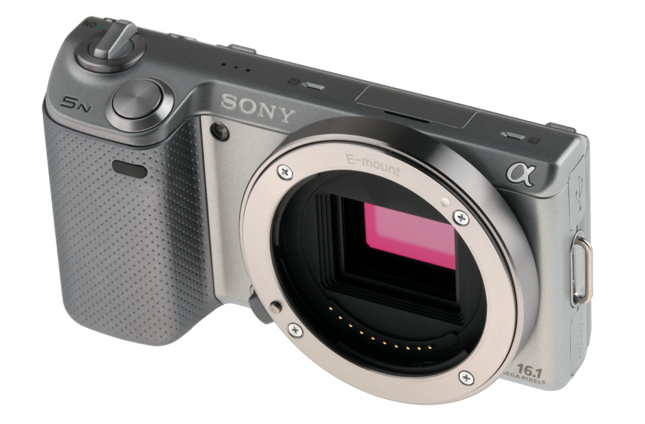
1. Sony NEX-5N / 16,7-Mp, matrix 23.4x15.6 mm, display 3 ", max. Image resolution: 4912x3264, 269 g., 24 700 rub.
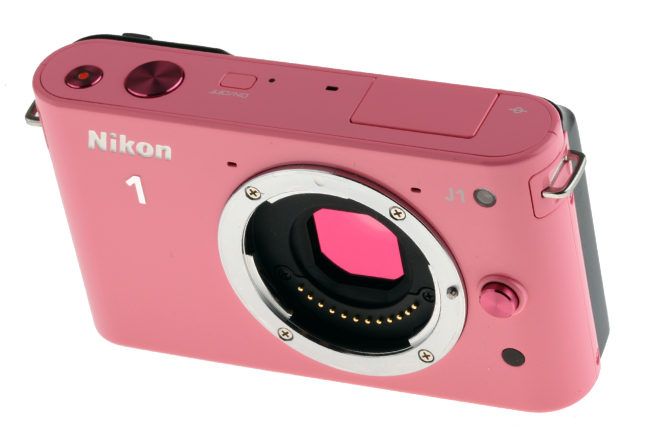
2. Nikon J1 / 10,1-, 13,2x8,8 mm, display 3 ", 3872x2592, $ 650 in the USA

3. Panasonic GF3 / 13,1-, 17,3x13,0 mm, display 3 ", 4000x3000, 319 g., 19 900 rub.
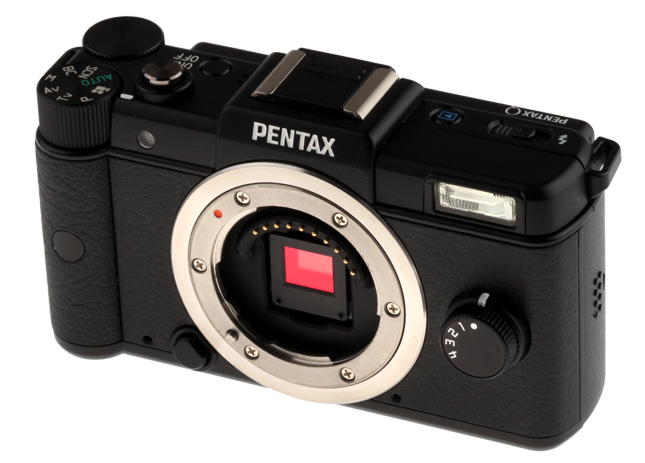
4. Pentax Q / 12.75-MP, 6.17x4.55 mm, display 3 ", 4000x3000, 235 g., 28,400 rubles.
Nomobile would not be Nomobile if it had not shot a video for this review. In the main role - Nikolay Turubar, who makes cautious conclusions about which of the mirrorless mirrors took which place on the pedestal:
Of the presented cameras, Sony has the largest matrix with its APS-C format, which sounds simply luxurious for its dimensions. However, she is also the most cumbersome (with a zoom lens) in the group. You can make an electronic camera unit with at least the size of a matchbox, but the optics requirements for large arrays cannot be fooled. It is followed by Panasonic and Nikon. In GF3, the well-known Micro 4: 3 is well known to everyone, while in J1 the matrix is slightly smaller - 1 inch in the diagonal.
The width of the camera body is about comparable, and Nikon is even slightly taller than Sony, so J1 fits the hand most adequately. But be that as it may, the Pentax Q can only be put in your pocket. It’s also the most expensive and most importantly - with the soap format 2/3 of the matrix, which is eight times less than 4: 3. During the day it still all right, but at high ISO it is no longer necessary to wait for the holiday So I had to compromise for the marketing title of “the smallest camera with an interchangeable lens.”
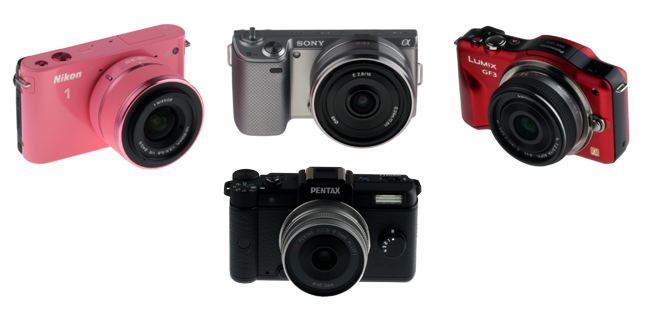
Pentax Q - the most beautiful and elegantly executed camera in the dough - finished with volcanite
As an example of a device with the most thoughtful and modern menu, I see Panasonic, where the touch screen will always help with a clear and adequate tab structure.
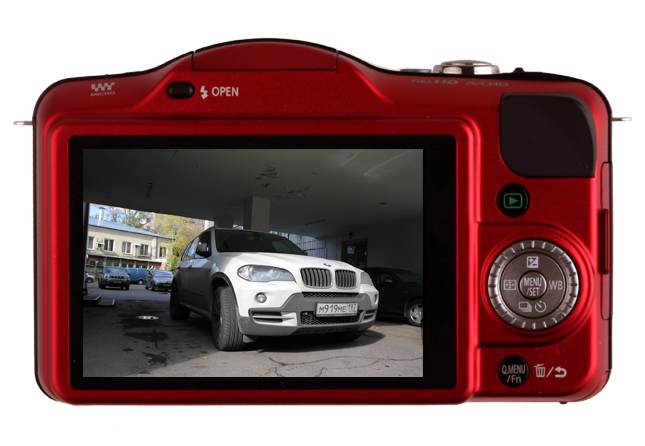
At Sony, it seems, the same touchscreen, and more spacious and even some theoretical instructions emerge on the use of modes. However, Sony's functionality is somehow sprayed into different groups, which is often misleading. Accidental pressing of the wrong button takes the user into some kind of jungle completely unnecessary settings.

The touchscreen is a powerful drug and after it the usual control on the other two cameras seems somewhat oaky, despite the abundance of auxiliary wheels and ringlets. Especially when the whole organization is sharpened for other priorities, such as Nikon. On the wheel, where the shooting modes are usually labeled, now J1 has an “intelligent mode”, video recording (duplicated without a separate button) and some other nonsense - only a quarter of the wheel is used! Or tell me, what will you use more often - to change the ISO or set the self-timer delay? In Nikon, a separate button is allocated for this case, and ISO and white balance are hidden in a long menu list. It would seem that in the priority mode of the aperture, it is logical to change its value with a neat joystick (at least in the manual mode that's how it happens) - but no. Now you have to pull the little swinging key in the upper part of the device, which is not immediately noticeable. But actually, even the most inconvenient menu is easy to get used to if you live with a camera for more than a couple of days. By the way, the lenses of the Nikon J1 must be released from the "lock" to bring it into position - just like the Olympus PEN.

Pentax Q with control is much better - there is a separate ISO button, white balance, and modes. There is even a separate wheel to switch the color filters of the post-processing photo (4 modes), but in general some program like Silkypix will give the picture various film effects where it is more exciting and varied.

Built-in retractable flashes are equipped with all cameras except Sony. At Sony, it is external in the kit and has a twist to the ceiling. Of the other cameras, the connector for an external flash generally has only one, and the smallest is the Pentax Q.
Also, all cameras shoot video at 1920x1080 with stereo sound - the only difference is in frame rates and formats. The resulting video files were then played on a Dune Prime 3.0 media player connected to an AV receiver and plasma TV. Nikon and Pentax fixed the video to a file with the .MOV extension and the AAC sound, which the Dune for the receiver still took to PCM 16/48 stream. Sony and Panasonic produced AVCHD video in .MTS format and sound in a dual-channel Dolby Digital. Camera NEX-5N can do 60 Hz Full HD in progressive t. 1080 / 60p, while GF3 has 60 Hertz only in interlace - i.e. 1080 / 60i, and progressive will only 1280x720. Nikon and Pentax Q have a similar situation 1080 / 60i, 1080 / 30p or 720 / 60p.
An important factor when shooting with bridge cameras is the sound of the shutter release. If someone hoped that a loud bang would be a thing of the past with acquisitions of a mirrorless camera, then in the case of Sony and Panasonic these hopes are in vain. Lamellae that cover the matrix at the time of reading the data, clap in them be healthy, only the sound is more squeaky than that of DSLRs.
Another disadvantage is the continuation of advantages - alas, the low body with a relatively massive zoom lens does not contribute to perfect balance in the hand. The third disadvantage is also associated with the advantage of bridge cameras - the ease that engineers so stubbornly sought. Yes, they achieved it - but now it is not easy to take a picture at 1/20 s without blurring, while Panasonic, for example, does not have a stabilizer in either the camera or the 14 / 2.5 lens. According to the cumulative time (focus / shutter release) in low light conditions, the leaders were Sony and Nikon. It should also be added that Nikon had the smoothest image on the display when sighting, which is not surprising - the newest fast processor in conjunction with a relatively small matrix.
I’ll make a reservation right away that all the demo samples were submitted to the test without software, so it wasn’t possible to thoroughly examine RAW files. My general wish to the camera manufacturers is a reminder of the bride's replica from the Gogol's work: “If only the Sony matrix and the Pentax Q case, and the Panasonic optics, so that it was quiet in operation as Nikon”. In a word, I didn’t have a single favorite, you can only bring the strengths and weaknesses of each model, each of which in itself does not look like an outsider. So who works best with the image?

For obvious reasons, Sony had the best plastic design (i.e. smoothness of shadow transition and microcontrast) and an almost imperceptible level of noise at high ISO. It was the NEX-5N that the video picture looked more like a normal camcorder shooting, the rest of the cameras showed harshly and with jerks when transmitting motion. At the same time, the primacy of sound quality in video recording turned out to be behind the Nikon J1.

At the same time, Sony lenses did not become champions in sharpness, giving way to Panasonic optics - and after all, the company has even more brutal fixes like 20 / 1.7 or 25 / 1.4. The picture of the Nikon J1 on both lenses also boasts excellent sharpness and low for the size of its matrix noises, but at Panasonic at high ISO their level is still noticeably lower. However, GF3, as practice has shown, does not very well keep the light drops and is inclined to “swallow the details” in bright areas, which indicates a limited dynamic range of the camera - in any case, compared with its predecessor Panasonic GF2.

Hey, how did Pentax Q do it? The impressions are also interesting and contradictory: with sharpness, the full lens has full order. Well, who would doubt, after all, this is not a zoom. But at the same time, Standard Prime is prone to barrel distortion. The good news is that even at high ISO1600 noise levels, the Pentax Q demonstrates fantastic results for a matrix of this format! However, the narrow dynamic range of the sensor threatens to whiteness on light surfaces in the street. In general, I would recommend the Pentax Q for conditions of relatively low illumination - there its qualities will become most obvious. Interestingly, although it did not become a champion in videotaping, it nevertheless, in combination with the 1.9 lens, giving a shallow depth of field, the result resembles the established post-production style of modern video clips - high contrast, bright colors and “white sky”. For young people with creative claims - it itself.

Of course, taking into account pseudo-film filter effects and future lenses like Toy Lens, the manufacturer cannot avoid the ironic accusations of “hipster”, but of all the presented cameras, it is the best gift for the role of an expensive present.
! Information about each image is available in the file properties, which, in turn, are available after downloading the image in full resolution.
Nikon J1 :
Sony NEX-5N :
Panasonic GF3 :
Pentax Q :
Sony NEX-5N :
+ the best quality of photos and videos in a group, external flash included
- optics could be sharper, with a zoom lens ceasing to be compact and not very comfortable in grip
Panasonic GF3 :
+ quality standard optics, touch screen and clear menu
- suddenly (!) Cropped dynamic range of the image
Nikon J1 :
+ body design, optics sharpness, speed and quiet operation
- the menu requires addiction
Pentax Q :
+ dimensions, performance, convenient control, shoe for external flash
- dynamic range limitations associated with matrix size

Disclaimer: different parameters are important for different people in the cameras, and unfortunately we could not cover all the features and features in this comparative test. In general, do not judge strictly, we tried :)
')
Background
“I got a soap dish - buy a DSLR!” - once this expression meant that a person intends to buy a normal camera, which finally makes good pictures. In fact, the mirror pentaprism has nothing to do with the beauty of the picture - it’s just an optical block of guidance on the subject. The quality of digital photography directly depends on two things:
1. The size of the photosensitive matrix should be as large as possible - and not in pixels, but over the physical area. Ideally, like the so-called full-matrix devices like the Canon 5D, where it corresponds to the frame dimensions of a 35-mm film, that is, 36 × 24 mm.
2. The quality of the lens optics. At the same time, he should have as much aperture as possible, which will help you out in low light without resorting to a flash. To do this, we look at the luminosity value at the end of the lens - the figure should be as small as possible. Whoever has a head inversely proportional, just imagine the Olympic table: the champion has one, the silver has two, and so on.
Where, then, did the clingy analogy cling to means qualitative?
Even in the film era, SLR cameras provided more accurate guidance on long-focus (over 100 mm) lenses. They were the first to get autofocus, displacing more compact rangefinder cameras from the market, after all. It is worth noting that the rangefinder optics were not only smaller but also often much better in quality (take the same Leica).

Leica M9 / 18,5-MP, 36x24 mm, 2.5 "display, 5212x3472 pixels, 420,000 rubles for a kit
The bulky dimensions of the cases of SLR cameras came in handy when the first digital APS matrixes began to appear. And although today, like 10 years ago, household mirrors of the matrix are still one and a half times smaller than the film frame, the quality of the pictures on them is noticeably better than that of compacts on sensors with children's nails. In addition, the mirror-shutter design of such cameras allowed to turn on the matrix only at the time of shooting, improving its working conditions.
During these ten years, there have been two factors - technical and everyday. First, the opportunity to make more compact electronic modules in the camera. And secondly, many male amateur photo amateurs have come to disappointing conclusions for themselves. At one time, in obedience to a semi-conscious phallic cult, they were hung up, like Conan the barbarian, with solid ammunition with huge telephones. However, instead of girls, various unpleasant people like Gopniks or guards showed more attention to them (which is, in general, communicating vessels at different times of the day). And by the end of the day, the back didn’t care what it was to hurt - even from the kicks of the crime, even from the weight of the backpack with the lenses. People began to be interested in less overall solutions while maximizing the quality of digital SLRs.
Matrix standard 4: 3 size of 17.3 × 13 mm (which is two times smaller than the Full Frame) was first put Olympus and Panasonic th on the mirror model. The further development of the format in 2008 was expressed in the Micro 4: 3 system: a whole scattering of small bridge cameras appeared with interchangeable lenses on which there was no mirror anymore, and the image was sighted on the screen. The success of the hybrid models involved in the subject and other manufacturers who responded to this demand in different ways. Today, I myself am picking up something compact and able to shoot decently, so I was just glad to have the opportunity to compare the capabilities of several modern bridge cameras.

Pentax Q, Nikon J1, Lumix GF3, Sony NEX-5N
For the test, all four cameras with lenses arrived in one lightweight box the size of a package for one (!) DSLR with a whale lens. Despite the general class, the company came across a motley one:

1. Sony NEX-5N / 16,7-Mp, matrix 23.4x15.6 mm, display 3 ", max. Image resolution: 4912x3264, 269 g., 24 700 rub.

2. Nikon J1 / 10,1-, 13,2x8,8 mm, display 3 ", 3872x2592, $ 650 in the USA

3. Panasonic GF3 / 13,1-, 17,3x13,0 mm, display 3 ", 4000x3000, 319 g., 19 900 rub.

4. Pentax Q / 12.75-MP, 6.17x4.55 mm, display 3 ", 4000x3000, 235 g., 28,400 rubles.
Video review
Nomobile would not be Nomobile if it had not shot a video for this review. In the main role - Nikolay Turubar, who makes cautious conclusions about which of the mirrorless mirrors took which place on the pedestal:
Matrix and dimensions
Of the presented cameras, Sony has the largest matrix with its APS-C format, which sounds simply luxurious for its dimensions. However, she is also the most cumbersome (with a zoom lens) in the group. You can make an electronic camera unit with at least the size of a matchbox, but the optics requirements for large arrays cannot be fooled. It is followed by Panasonic and Nikon. In GF3, the well-known Micro 4: 3 is well known to everyone, while in J1 the matrix is slightly smaller - 1 inch in the diagonal.
The width of the camera body is about comparable, and Nikon is even slightly taller than Sony, so J1 fits the hand most adequately. But be that as it may, the Pentax Q can only be put in your pocket. It’s also the most expensive and most importantly - with the soap format 2/3 of the matrix, which is eight times less than 4: 3. During the day it still all right, but at high ISO it is no longer necessary to wait for the holiday So I had to compromise for the marketing title of “the smallest camera with an interchangeable lens.”

Pentax Q - the most beautiful and elegantly executed camera in the dough - finished with volcanite
Functional and Management
As an example of a device with the most thoughtful and modern menu, I see Panasonic, where the touch screen will always help with a clear and adequate tab structure.

At Sony, it seems, the same touchscreen, and more spacious and even some theoretical instructions emerge on the use of modes. However, Sony's functionality is somehow sprayed into different groups, which is often misleading. Accidental pressing of the wrong button takes the user into some kind of jungle completely unnecessary settings.

The touchscreen is a powerful drug and after it the usual control on the other two cameras seems somewhat oaky, despite the abundance of auxiliary wheels and ringlets. Especially when the whole organization is sharpened for other priorities, such as Nikon. On the wheel, where the shooting modes are usually labeled, now J1 has an “intelligent mode”, video recording (duplicated without a separate button) and some other nonsense - only a quarter of the wheel is used! Or tell me, what will you use more often - to change the ISO or set the self-timer delay? In Nikon, a separate button is allocated for this case, and ISO and white balance are hidden in a long menu list. It would seem that in the priority mode of the aperture, it is logical to change its value with a neat joystick (at least in the manual mode that's how it happens) - but no. Now you have to pull the little swinging key in the upper part of the device, which is not immediately noticeable. But actually, even the most inconvenient menu is easy to get used to if you live with a camera for more than a couple of days. By the way, the lenses of the Nikon J1 must be released from the "lock" to bring it into position - just like the Olympus PEN.

Pentax Q with control is much better - there is a separate ISO button, white balance, and modes. There is even a separate wheel to switch the color filters of the post-processing photo (4 modes), but in general some program like Silkypix will give the picture various film effects where it is more exciting and varied.

Built-in retractable flashes are equipped with all cameras except Sony. At Sony, it is external in the kit and has a twist to the ceiling. Of the other cameras, the connector for an external flash generally has only one, and the smallest is the Pentax Q.
Also, all cameras shoot video at 1920x1080 with stereo sound - the only difference is in frame rates and formats. The resulting video files were then played on a Dune Prime 3.0 media player connected to an AV receiver and plasma TV. Nikon and Pentax fixed the video to a file with the .MOV extension and the AAC sound, which the Dune for the receiver still took to PCM 16/48 stream. Sony and Panasonic produced AVCHD video in .MTS format and sound in a dual-channel Dolby Digital. Camera NEX-5N can do 60 Hz Full HD in progressive t. 1080 / 60p, while GF3 has 60 Hertz only in interlace - i.e. 1080 / 60i, and progressive will only 1280x720. Nikon and Pentax Q have a similar situation 1080 / 60i, 1080 / 30p or 720 / 60p.
In work
An important factor when shooting with bridge cameras is the sound of the shutter release. If someone hoped that a loud bang would be a thing of the past with acquisitions of a mirrorless camera, then in the case of Sony and Panasonic these hopes are in vain. Lamellae that cover the matrix at the time of reading the data, clap in them be healthy, only the sound is more squeaky than that of DSLRs.
Another disadvantage is the continuation of advantages - alas, the low body with a relatively massive zoom lens does not contribute to perfect balance in the hand. The third disadvantage is also associated with the advantage of bridge cameras - the ease that engineers so stubbornly sought. Yes, they achieved it - but now it is not easy to take a picture at 1/20 s without blurring, while Panasonic, for example, does not have a stabilizer in either the camera or the 14 / 2.5 lens. According to the cumulative time (focus / shutter release) in low light conditions, the leaders were Sony and Nikon. It should also be added that Nikon had the smoothest image on the display when sighting, which is not surprising - the newest fast processor in conjunction with a relatively small matrix.
Quality
I’ll make a reservation right away that all the demo samples were submitted to the test without software, so it wasn’t possible to thoroughly examine RAW files. My general wish to the camera manufacturers is a reminder of the bride's replica from the Gogol's work: “If only the Sony matrix and the Pentax Q case, and the Panasonic optics, so that it was quiet in operation as Nikon”. In a word, I didn’t have a single favorite, you can only bring the strengths and weaknesses of each model, each of which in itself does not look like an outsider. So who works best with the image?

For obvious reasons, Sony had the best plastic design (i.e. smoothness of shadow transition and microcontrast) and an almost imperceptible level of noise at high ISO. It was the NEX-5N that the video picture looked more like a normal camcorder shooting, the rest of the cameras showed harshly and with jerks when transmitting motion. At the same time, the primacy of sound quality in video recording turned out to be behind the Nikon J1.

At the same time, Sony lenses did not become champions in sharpness, giving way to Panasonic optics - and after all, the company has even more brutal fixes like 20 / 1.7 or 25 / 1.4. The picture of the Nikon J1 on both lenses also boasts excellent sharpness and low for the size of its matrix noises, but at Panasonic at high ISO their level is still noticeably lower. However, GF3, as practice has shown, does not very well keep the light drops and is inclined to “swallow the details” in bright areas, which indicates a limited dynamic range of the camera - in any case, compared with its predecessor Panasonic GF2.

Hey, how did Pentax Q do it? The impressions are also interesting and contradictory: with sharpness, the full lens has full order. Well, who would doubt, after all, this is not a zoom. But at the same time, Standard Prime is prone to barrel distortion. The good news is that even at high ISO1600 noise levels, the Pentax Q demonstrates fantastic results for a matrix of this format! However, the narrow dynamic range of the sensor threatens to whiteness on light surfaces in the street. In general, I would recommend the Pentax Q for conditions of relatively low illumination - there its qualities will become most obvious. Interestingly, although it did not become a champion in videotaping, it nevertheless, in combination with the 1.9 lens, giving a shallow depth of field, the result resembles the established post-production style of modern video clips - high contrast, bright colors and “white sky”. For young people with creative claims - it itself.

Of course, taking into account pseudo-film filter effects and future lenses like Toy Lens, the manufacturer cannot avoid the ironic accusations of “hipster”, but of all the presented cameras, it is the best gift for the role of an expensive present.
Snapshots / video
! Information about each image is available in the file properties, which, in turn, are available after downloading the image in full resolution.
Nikon J1 :
 |  |
 |  |
 |  |
Sony NEX-5N :
 |  |
 |  |
Panasonic GF3 :
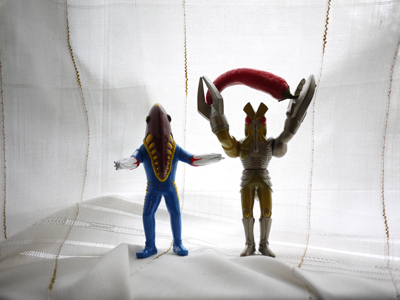 |  |
 | 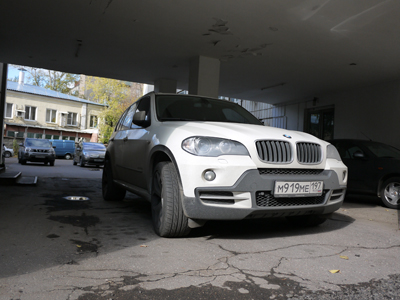 |
Pentax Q :
 |  |
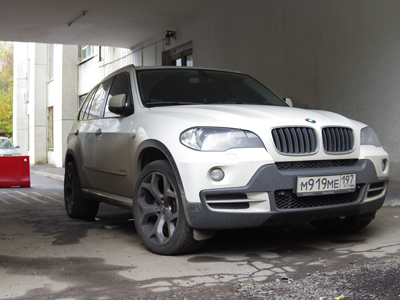 |  |
Total
Sony NEX-5N :
+ the best quality of photos and videos in a group, external flash included
- optics could be sharper, with a zoom lens ceasing to be compact and not very comfortable in grip
Panasonic GF3 :
+ quality standard optics, touch screen and clear menu
- suddenly (!) Cropped dynamic range of the image
Nikon J1 :
+ body design, optics sharpness, speed and quiet operation
- the menu requires addiction
Pentax Q :
+ dimensions, performance, convenient control, shoe for external flash
- dynamic range limitations associated with matrix size
Source: https://habr.com/ru/post/131421/
All Articles